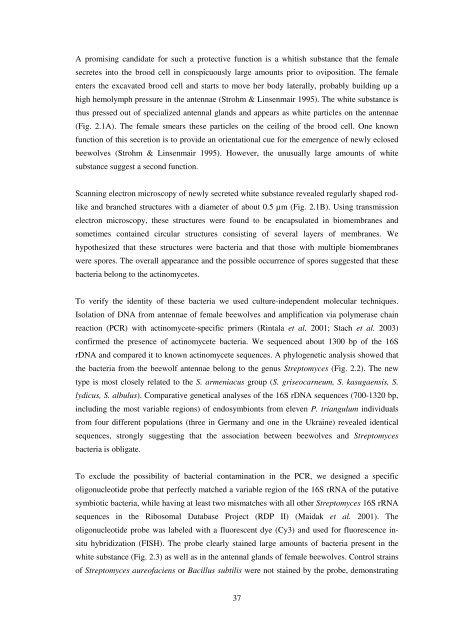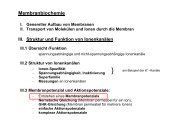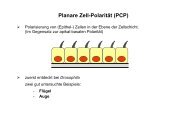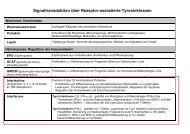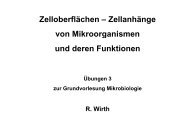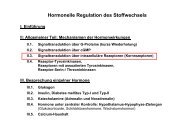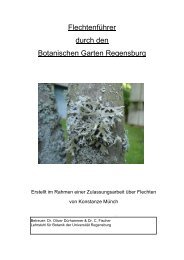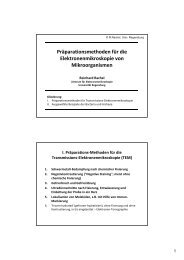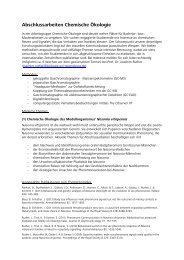PhD thesis
PhD thesis
PhD thesis
Create successful ePaper yourself
Turn your PDF publications into a flip-book with our unique Google optimized e-Paper software.
A promising candidate for such a protective function is a whitish substance that the female<br />
secretes into the brood cell in conspicuously large amounts prior to oviposition. The female<br />
enters the excavated brood cell and starts to move her body laterally, probably building up a<br />
high hemolymph pressure in the antennae (Strohm & Linsenmair 1995). The white substance is<br />
thus pressed out of specialized antennal glands and appears as white particles on the antennae<br />
(Fig. 2.1A). The female smears these particles on the ceiling of the brood cell. One known<br />
function of this secretion is to provide an orientational cue for the emergence of newly eclosed<br />
beewolves (Strohm & Linsenmair 1995). However, the unusually large amounts of white<br />
substance suggest a second function.<br />
Scanning electron microscopy of newly secreted white substance revealed regularly shaped rod-<br />
like and branched structures with a diameter of about 0.5 µm (Fig. 2.1B). Using transmission<br />
electron microscopy, these structures were found to be encapsulated in biomembranes and<br />
sometimes contained circular structures consisting of several layers of membranes. We<br />
hypothesized that these structures were bacteria and that those with multiple biomembranes<br />
were spores. The overall appearance and the possible occurrence of spores suggested that these<br />
bacteria belong to the actinomycetes.<br />
To verify the identity of these bacteria we used culture-independent molecular techniques.<br />
Isolation of DNA from antennae of female beewolves and amplification via polymerase chain<br />
reaction (PCR) with actinomycete-specific primers (Rintala et al. 2001; Stach et al. 2003)<br />
confirmed the presence of actinomycete bacteria. We sequenced about 1300 bp of the 16S<br />
rDNA and compared it to known actinomycete sequences. A phylogenetic analysis showed that<br />
the bacteria from the beewolf antennae belong to the genus Streptomyces (Fig. 2.2). The new<br />
type is most closely related to the S. armeniacus group (S. griseocarneum, S. kasugaensis, S.<br />
lydicus, S. albulus). Comparative genetical analyses of the 16S rDNA sequences (700-1320 bp,<br />
including the most variable regions) of endosymbionts from eleven P. triangulum individuals<br />
from four different populations (three in Germany and one in the Ukraine) revealed identical<br />
sequences, strongly suggesting that the association between beewolves and Streptomyces<br />
bacteria is obligate.<br />
To exclude the possibility of bacterial contamination in the PCR, we designed a specific<br />
oligonucleotide probe that perfectly matched a variable region of the 16S rRNA of the putative<br />
symbiotic bacteria, while having at least two mismatches with all other Streptomyces 16S rRNA<br />
sequences in the Ribosomal Database Project (RDP II) (Maidak et al. 2001). The<br />
oligonucleotide probe was labeled with a fluorescent dye (Cy3) and used for fluorescence in-<br />
situ hybridization (FISH). The probe clearly stained large amounts of bacteria present in the<br />
white substance (Fig. 2.3) as well as in the antennal glands of female beewolves. Control strains<br />
of Streptomyces aureofaciens or Bacillus subtilis were not stained by the probe, demonstrating<br />
37


